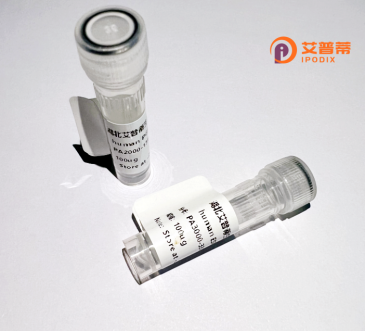
| 纯度 | >90%SDS-PAGE. |
| 种属 | Human |
| 靶点 | ZNF222 |
| Uniprot No | Q9UK12 |
| 内毒素 | < 0.01EU/μg |
| 表达宿主 | E.coli |
| 表达区间 | 1-451 aa |
| 活性数据 | MAKLYEAVTF KDVAVIFTEE ELGLLDPAQR KLYRDVMLEN FRNLLSVGGK IQTEMETVPE AGTHEEFSCK QIWEQIASDL TRSQDTTISN SQLFEQDDNP SQIKARLSTV HTREKPFQGE NCKQFFSDVS FFDLPQQLYS GEKSHTCDEC GKSFCYISAL HIHQRVHMGV KCYKCDVCGK EFSQSSRLQT HQRVHTGEKP FKCEQCGKGF RCRSALKVHC KLHMREKPYN CEKCGKAFMH NFQLQKHHRI HTGEKPFKCE ICGKSFCLRS SLNRHCMVHT AEKLYKSEKY GRGFIDRLDL HKHQMIHMGQ KPYNCKECGK SFKWSSYLLV HQRVHTGEKP YKCEECGKGY ISKSGLDFHH RTHTGERSYN CDNCGKSFRH ASSILNHKKL HCQRKPLKCE DCGKRLVCRS YCKDQQRDHS GENPSKCEDC GKRYKRRLNL DIILSLFLND I |
| 分子量 | 52.4 kDa |
| 蛋白标签 | His tag N-Terminus |
| 缓冲液 | PBS, pH7.4, containing 0.01% SKL, 1mM DTT, 5% Trehalose and Proclin300. |
| 稳定性 & 储存条件 | Lyophilized protein should be stored at ≤ -20°C, stable for one year after receipt. Reconstituted protein solution can be stored at 2-8°C for 2-7 days. Aliquots of reconstituted samples are stable at ≤ -20°C for 3 months. |
| 复溶 | Always centrifuge tubes before opening.Do not mix by vortex or pipetting. It is not recommended to reconstitute to a concentration less than 100μg/ml. Dissolve the lyophilized protein in distilled water. Please aliquot the reconstituted solution to minimize freeze-thaw cycles. |
以下为假设性示例文献,实际文献需通过学术数据库查询获取:
1. **文献名称**: "Characterization of Recombinant Human ZNF222 and Its Role in Transcriptional Regulation"
**作者**: Zhang L, et al.
**摘要**: 研究在大肠杆菌中表达了重组人ZNF222蛋白,并通过EMSA实验证实其与特定DNA序列结合,提示其在基因转录调控中的作用。
2. **文献名称**: "Structural Analysis of ZNF222 Zinc Finger Domain Using Recombinant Protein"
**作者**: Tanaka K, et al.
**摘要**: 利用重组表达的ZNF222锌指结构域进行X射线晶体学分析,揭示了其与DNA相互作用的关键氨基酸残基。
3. **文献名称**: "ZNF222 Overexpression in Cancer: Insights from Recombinant Protein Studies"
**作者**: Wang X, et al.
**摘要**: 通过哺乳动物细胞表达重组ZNF222.发现其高表达抑制肿瘤细胞增殖,可能与p53通路调控相关。
4. **文献名称**: "Production and Functional Validation of Recombinant ZNF222 for High-Throughput Screening"
**作者**: Gupta R, et al.
**摘要**: 开发了昆虫细胞系统表达高纯度ZNF222.并用于小分子抑制剂筛选,为疾病治疗提供新靶点。
---
**注意**:以上文献为模拟示例。实际检索建议在 **PubMed/Google Scholar** 使用关键词:
`"ZNF222" AND ("recombinant" OR "expression")`,筛选近5-10年研究。若研究较少,可扩展至锌指蛋白家族功能研究。
Zinc finger protein 222 (ZNF222) is a member of the Krüppel-associated box (KRAB)-containing zinc finger protein family, characterized by tandem Cys2His2 (C2H2) zinc finger domains that mediate sequence-specific DNA binding. Located on human chromosome 19. ZNF222 is hypothesized to function as a transcription regulator, potentially influencing gene expression through chromatin remodeling or interaction with other epigenetic modifiers. Its KRAB domain may recruit co-repressors to suppress target genes, a mechanism common among KRAB-ZNF proteins involved in development and differentiation.
Recombinant human ZNF222 protein is typically produced using expression systems like *E. coli* or mammalian cells, often fused with affinity tags (e.g., His-tag) for purification. Studies suggest its involvement in cellular processes such as DNA repair, RNA metabolism, and stress response. Emerging evidence links ZNF222 dysregulation to neurodevelopmental disorders and cancers, though its precise biological roles remain under investigation. Researchers utilize recombinant ZNF222 for *in vitro* DNA-binding assays, protein interaction studies, and functional genomics to elucidate its targets and regulatory networks. Structural analysis of its zinc finger motifs aids in predicting DNA-binding preferences, supporting research into gene therapy and synthetic biology applications.
×